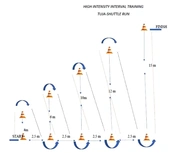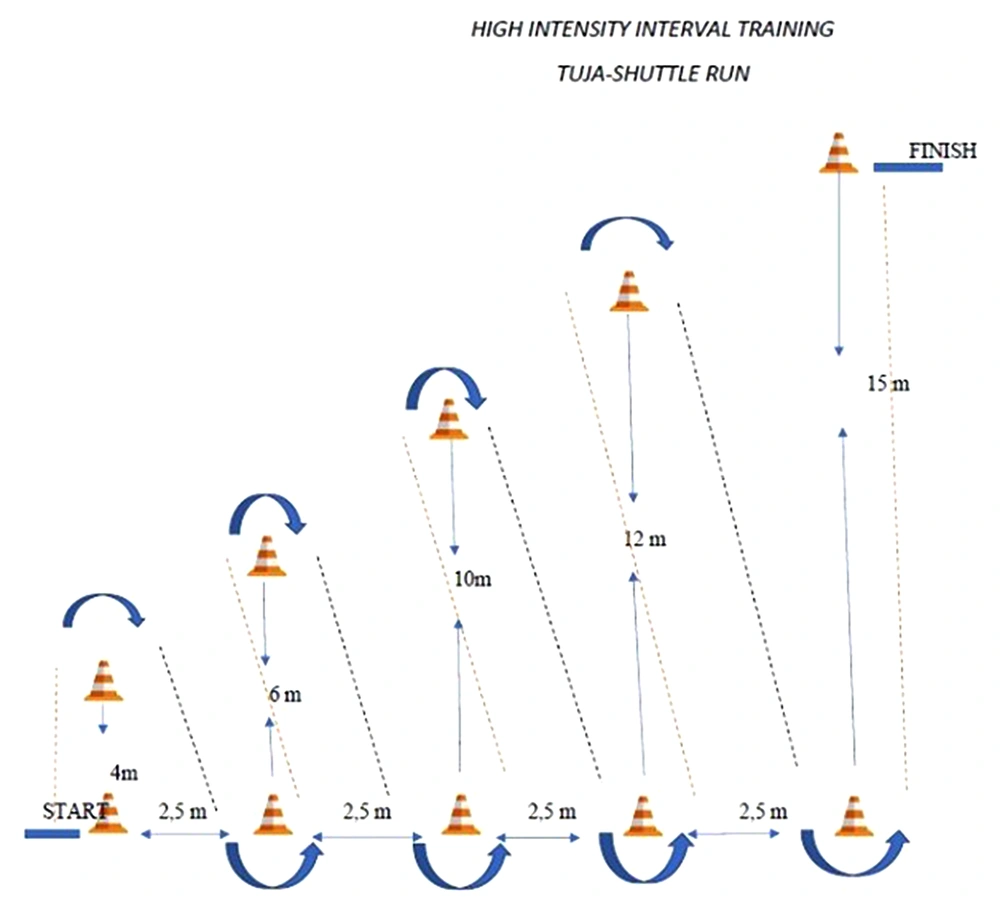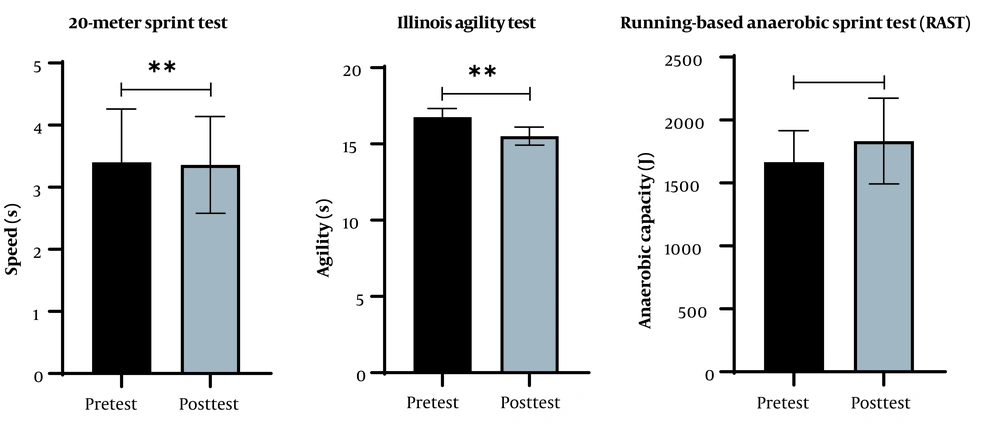1. Background
The physical performance of an athlete is directly proportional to his/her achievements. Performance can be determined by measuring the physical ability to evaluate the amount of energy produced through aerobic and anaerobic metabolism in skeletal muscles (1, 2). The improvement of athletes’ physical abilities should be adjusted to the characteristics of the sport, their functional anatomy, and the physical bio-motor of sports. An improvement in the physical ability of athletes in terms of aerobic and anaerobic endurance can be achieved through a variety of training methods, one of which is high-intensity interval training (HIIT). A notable study showed that several forms of interval training with an exercise intensity of 130% VO2max, implemented in an exercise program, could increase power output, anaerobic capacity, and sprint ability (3). High-intensity interval training should be properly planned and correctly executed to be effective. In 2015, a study on elite rowers’ anaerobic energy measured during exercise (high-intensity, sourced endurance up to 90%, continuous submaximal exercise below the blood lactate threshold (< 4 mmol/L), 60 - 120 minutes per session, twice per day) showed that interval training had an important role in increasing anaerobic speed and capacity (4). Moreover, the incorporation of special speed training tailored to the needs of sports into the initial phase of conditioning has been shown to contribute to the improvement of specific anaerobic performance, e.g., acceleration, maximum speed, and agility, and boost the physical abilities of athletes during training.
In order to increase speed, training programs should be properly designed so that the athlete is trained to move quickly and repeatedly at high intensity. In the case of HIIT, programs should be carefully designed based on the athlete’s condition in order to improve several aspects of physical bio-motor features. According to Fajrin et al. (5), HIIT strictly implemented following a scientific approach at the desired intensity (80 - 95%) enhanced explosive power, speed, and agility by an average of 15.9%, 5.9%, and 6.3%, respectively. High-intensity training programs are the key to success in increasing explosive power, speed, and agility. Similarly, Thomas et al. concluded that HIIT could improve anaerobic adaptation and specific neuromuscular abilities according to the maximal oxygen volume (VO2max) and 95 - 100% of maximum sprint speed (6).
In addition, HIIT can improve the endurance performance of athletes based on intensity, duration, and optimal recovery, noting an improvement in the performance of highly trained athletes at specific training intensities (50 - 70 %) (1). Meanwhile, submaximal interval training (4 - 8 minutes, 85% peak power output, recovery of 90 seconds) and supramaximal training (12 - 30 seconds, 175% peak power output, recovery of 4 - 5 minutes) can also increase the endurance capability (7). Another advantage of HIIT is its ability to improve the athlete’s performance in a relatively short time. A study on skaters pointed out that HIIT at an intensity of 115% V VO2max compared to an intensity of 130% V VO2max increased the metabolic rate in female inline skaters. In addition, six-week aerobic training and continuous low-intensity resistance training, as an alternative to endurance training, were observed to improve aerobic and anaerobic performance in a short period of time (8).
Circuit training and low-volume HIIT are popular training methods for increasing VO2max and are routinely studied by researchers and health and fitness professionals (9). The workouts of HIIT are performed at specific intervals and can be defined as a series of repetitive exercises of short to moderate duration (10 seconds to 5 minutes) performed at an intensity greater than that of the anaerobic threshold (10). In other words, this type of exercise is performed by repeating the same form of activities interspersed by rest intervals between the episodes where subsequent rounds are repeated with an intensity equal to or greater than the anaerobic threshold. The purpose of repetition in HIIT is to adapt the physiological systems involved in a specific type of endurance exercise. Stevens et al. showed that HIIT at submaximal and maximum intensity with a longer duration at 80 - 100% of VO2max power output for 1 - 5 minutes along with short-duration supramaximal sprint-interval training (175% power output VO2max, 10 - 30 seconds, running and bicycle riding) positively affected cardiovascular and muscular metabolic adaptation and improved aerobic performance and anaerobic adaptation (4). Most previous studies have focused on the effects of HIIT on aerobic capacity, while studies investigating its effects on anaerobic capacity are less frequent (11).
In their study, Sökmen et al., the sample was recreationally active adults but not athletes and imitated pre-season conditions to compare the effects of sprint interval training and endurance training on anaerobic ability, running ability, and muscle strength. The results showed that sprint interval training with active rest periods (using a 200-meter sprint and an active recovery distance of 200 m, the ratio of 1: 3 for work time to recovery) performed better than endurance training. Sökmen et al. also recommend that sprint interval training (as an intermittent high-intensity activity with light and active recovery times) had a greater transfer effect and could be applied for playing sports such as football, basketball, tennis, badminton, lacrosse, ice hockey, and field hockey. The interval between sprint training and rest episodes can be increased or decreased based on the athlete’s fitness, the sport's energy system, the duration of the competition, and the physiological and fitness demands of sports (3). The HIIT model that can suit the requirements of various sports is still unknown. The Tuja-Shuttle Run exercise model is a modification of the existing HIIT model adjusted based on the characteristics and intensity of various sports.
The Tuja-Shuttle Run exercise model developed by researchers is a modified form of the HIIT procedure comprising various types of training starting from a short 4-meter run with changing directions at a controlled speed, followed by running longer distances (6, 10, and 12 to 15 m) adjusted to the characteristics and intensity of various sports. In this regard, HIIT programs based on the Tuja-Shuttle Run model can provide a more effective exercise strategy and can be applied to various sports. Based on this, we developed a HIIT training protocol based on the Tuja-Shuttle Run model to increase speed, agility, and anaerobic capacity.
2. Objectives
The purpose of this study was to analyze the impact of a Tuja-Shuttle Run model of HIIT on speed, agility, and anaerobic capacity.
3. Methods
This research employed a quasi-experimental one-group pretest-posttest design. The study population included female handball athletes in East Java, recruited by purposive sampling regarding the following eligibility criteria: Being a player of the East Java club, age of 17 - 26 years, and joining the training sessions for the National Sports Competition (PON) held by the Ministry of Sports Indonesia. Based on these criteria, a total of 14 subjects were enrolled in this study. All the procedures applied in this study complied with the World Medical Association’s Helsinki Declaration on the ethics of conducting research involving human subjects and were approved by the Health Research Ethics Committee, Faculty of Public Health Universitas Airlangga, Surabaya (No: 45/EA/KEPK/2021).
High-intensity interval training based on the Tuja-Shuttle Run exercise model was performed with six sets of 3 reps, intensity of 85 - 95% HRmax, and frequency of 3x/week for 8 weeks. The duration of each training session was 60 minutes, divided into a 10-minute warm-up, 40-minute core exercises, and a 10-minute cool-down session. A polar heart rate monitor (Polar H10 Heart Rate Sensor, Inc., USA) was used for monitoring the heart rate during the intervention (12, 13). Figure 1 illustrates the procedure of the HIIT program in the context of the Tuja-Shuttle Run exercise model for one repetition.
Speed was measured using the 20-meter sprint test (14), agility was assessed using the Illinois Agility Test (IAT) (15), and anaerobic capacity was determined using the running-based anaerobic sprint test (RAST) (16). Speed, agility, and anaerobic capacity were measured pre-intervention and 24 hours post-intervention (17). Data analysis was conducted using the paired sample t-test in SPSS version 20. The outcome was declared significant if the P-value was ≤ 0.05. The results were presented as mean ± SD.
4. Results
The data were obtained after eight weeks of conducting the training protocol. The data on speed, agility, and anaerobic capacity have been presented in Figure 2. As evidenced by the paired sample t-test, comparing pretest vs. posttest values revealed significant effect in speed (3.40 ± 0.86 vs. 3.36 ± 0.78 seconds, P ≤ 0.001), agility (16.76 ± 0.56 vs. 15.51 ± 0.59 seconds, P ≤ 0.001)), and anaerobic capacity (1666.65 ± 248.14 vs. 1832.72 ± 340.25 Joules, P ≤ 0.001).
5. Discussion
In this study, HIIT exercise was held in the context of the Tuja-Shuttle Run model in the form of a sprint interval program and then around the cone along paths with gradual extending distances, starting from 4 m to 6, 10, 12, and then 15 m. The range between the cones was 2.5 meters (Figure 1). Each repetition was performed in an expected duration of 20 - 22 seconds for six sets, each set consisting of three repetitions with rest between them (65% pulse). The pulse rate was monitored during the training to reach 90 - 95%. Activities in the form of a shuttle run allow for increasing the speed. Moreover, a shuttle run requires speeding up, which upgrades the speed function compared to continuous runs (18). Shuttle runs have been incorporated into various forms of HIIT training, improving speed performance and the ability to run at high intensity.
A previous study in the late 2000s assessing the effects of various models of HIIT on the performance of highly-trained young French athletes declared that HIIT (4 - 10 weeks, 2 sessions per week) improved high-intensity running capacity and repeated sprint performance. Handball is a complex sport played at different speeds and intensities during defending, attacking, finding positions, and keeping the opponent. Running back and forth becomes the main activity of these players during defense and attacks. Energy metabolism and movements during handball resemble those of basketball, demanding appropriate exercises adjusted to the endeavors made during the match in order to build players’ physical abilities (19). The results of the research by Štrumbelj et al. on basketball players showed that intermittent shuttle runs at various levels had a positive relationship with the performance of athletes during the match, and the shape of the shuttle run correlated with the average sprint time. The recent study also highlighted an association between the energy requirements of elite female basketball players and their positions in the game (20).
In addition to the shuttle form in the Tuja-Shuttle Run exercise model, Sökmen et al. argued that the selection of the model and the intensity of the exercise in HIIT were important determinants in increasing the aerobic and anaerobic capacity of athletes, as well as their performance. The general basis is to combine endurance training at the start of the season, followed by sprint training as a part of endurance exercise, particularly for athletes working on improving their sport-specific skills. Team sports athletes perform a wide variety of high-intensity movements during training and competition, including frequent directional changes, which contribute to their fatigue and related injuries. This is an important source of concern for coaches, especially in women’s team sports, as females' responses to fatigue differ from that of males, increasing the risk of injury among women. Therefore, the coach should understand how to increase the number of directional changes to optimize the player’s internal and external responses to sports activities, requiring designing and implementing appropriate programs and practical strategies (3).
Research by Ashton & Twist compared the effects of 10-m and 20-m intermittent shuttle runs with forward-backward directional changes carried out at the same speed and distance (4,000 m, 2-minute runs for 15 sets, 3 minutes of rest between sets) on changes in lactic acid, the pulse rate, and VO2max, reporting that the 20-m group showed slower lactic acid changes and higher pulse rate compared to the 10-m group, but VO2max showed no difference between the two groups (21). It is well-known that HIIT can improve cardiovascular function, as well as the metabolic and physical performance of athletes, and as an efficient physical exercise method in terms of execution time, help them achieve better results (19). So, HIIT can improve endurance performance in athletes. In a study, HIIT in the context of a sprint interval training model improved the anaerobic capacity, performance, and endurance among the rowers of 2,000 m ergo rowing (4). The same observation was noted by Laursen and Jenkins (7), investigating physiological responses resulting from submaximal exercises in untrained individuals. Moreover, HIIT had a positive impact on the endurance performance of highly trained athletes depending on aspects such as intensity, duration, and recovery (7).
Similar results were found in another study by Sporis et al. (22), who examined the effects of HIIT on elite football players, reporting that the most prominent impact was observed in the second year after starting the intervention. In the recent study, the HIIT drill design with a 4x4-minute model (i.e., running around a 20-m square pattern, exercise intensity of 90 - 95% at the maximum pulse rate, a rest period of 3 minutes, and 55 - 65% maximum heart rate) positively affected anaerobic endurance evidenced by an increase in the shuttle run anaerobic test. This outcome was superior to that of a shuttle run of 274.32 m. Exercise intensity, duration of exercise, and recovery are keys to the success of high-intensity training, where athletes carry out their activities at a submaximal level until reaching and maintaining the maximum capacity for a certain time period. In addition, athletes are allowed to rest for recovery by controlling the pulse at 55 - 56%, followed by repetitions with the same intensity and duration to exceed the excitatory threshold (22).
5.1. Conclusions
According to our findings, 8 weeks of HIIT employing a Tuja-Shuttle Run exercise model significantly increased speed, agility, and anaerobic capacity in female handball players. Therefore, coaches and athletes can use HIIT along with the Tuja-Shuttle Run exercise model to promote sports players’ physical performance, especially speed, agility, and anaerobic capacity.


